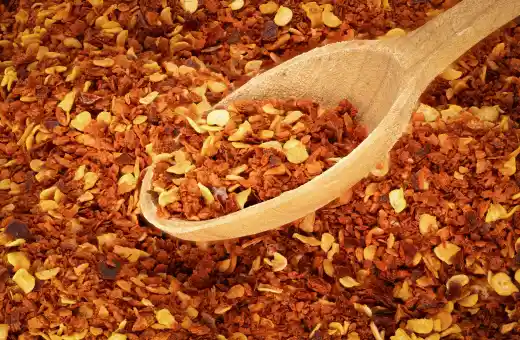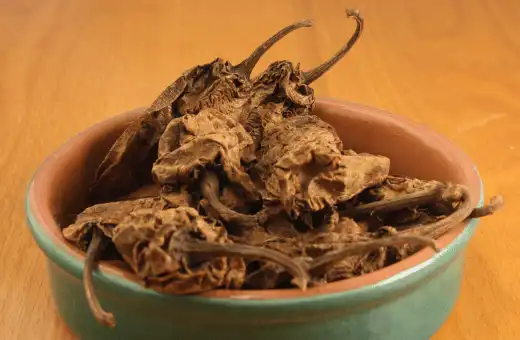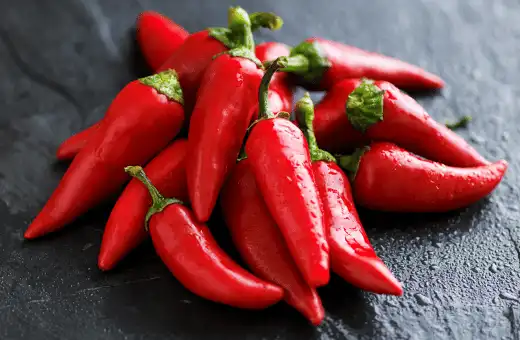Capsicum Baccatum, also known as Aji Amarillo, is a chili pepper commonly used in Latin American cuisine.
It’s unique flavor and spicy kick make it a popular ingredient in various dishes. However, it may only sometimes be available in your area.
In this post, I will communicate with you the 13 best substitutes for Capsicum Baccatum with the right ratios and ways to use them.
These alternatives will help you create flavorful dishes even without Capsicum Baccatum.
In short, " What can I use instead of capsicum baccatum?" Habanero Pepper, Jalapeno Pepper, Serrano Pepper, Cayenne Pepper, Red Pepper Flakes, Paprika, Guajillo Pepper, Anaheim Pepper, Thai Chili Pepper, Chipotle Pepper, Poblano/Ancho Pepper, Aleppo Pepper and many more.
What is capsicum baccatum, and what does capsicum baccatum taste like?
Capsicum baccatum, commonly known as Aji peppers or South American peppers, is a species of chili pepper native to South America. It is widely cultivated and consumed in countries like Peru, Bolivia, and Ecuador.
Capsicum baccatum peppers come in various shapes, sizes, and colors, ranging from small and round to long and tapered. The flavors and heat levels of the peppers can also vary within the species.
In terms of taste, Capsicum baccatum peppers generally offer a fruity and slightly sweet flavor with a moderate level of heat.
They are often described as having a tropical or citrusy taste, which sets them apart from other chili pepper varieties.
The heat level of Capsicum baccatum peppers typically ranges from mild to moderately hot, but there are some varieties that can be quite spicy.
These peppers are commonly used in South American cuisine, adding flavor, heat, and complexity to a variety of dishes.
It’s important to note that individual varieties within the Capsicum baccatum species may have slightly different flavor profiles and heat levels, so the specific taste experience can vary depending on the particular pepper being consumed.
Uses of capsicum baccatum
Capsicum baccatum, also known as aji peppers, is native to South America and is popular in many Latin American dishes.
It has a mildly sweet flavor and can vary in heat from mild to extra-spicy.
The peppers have a unique fruity aroma that makes them an excellent addition to salsas, soups, sauces, stews, and more. Aji peppers are often used as a topping for tacos or burritos or served with grilled meats.
They are great for roasting and can be stuffed with various fillings like cheese or vegetables.
Additionally, peppers are often used for their medicinal properties; they are believed to help reduce inflammation and improve digestion.
Capsicum baccatum can also be dried and powdered for use as a seasoning blend or chili powder.
Where to buy capsicum baccatum?
If you are looking for capsicum baccatum where to buy, there are a few other places you can go. Many specialty food stores carry it, as do some international grocery stores.
You can also order online from many retailers that provide a variety of diverse flavors and types of capsicum baccatum.
best substitutes capsicum baccatum
When looking for alternatives to Capsicum baccatum, one of the most popular peppers, there are many options to choose from.
Here are 20 great substitutes with ratios on how to use them for different dishes:
1. Habanero Pepper – A good substitute for capsicum baccatum

Habanero peppers are a hot chili pepper that can substitute for Capsicum Baccatum. Using the right ratio is essential because Habanero peppers are spicier than Capsicum Baccatum.
Ratio or measurement: For every Capsicum Baccatum, use half a Habanero pepper to achieve the right level of spiciness.
2. Jalapeno Pepper
Jalapeno peppers are another chili pepper that can be an ideal alternative. They are not as spicy as Habanero peppers and Capsicum Baccatum.
Ratio or measurement: You need to use two Jalapeno peppers for every Capsicum Baccatum.
3. Try Serrano Pepper to replace capsicum baccatum
Serrano Peppers are medium to hot chili pepper that can be a substitute for Capsicum Baccatum. These peppers are similar in spiciness to Capsicum Baccatum.
Ratio or measurement: For every Capsicum Baccatum, use one Serrano pepper.
4. Cayenne Pepper
Cayenne Pepper is a popular chili pepper because of its spiciness and rich flavor. This spice can substitute Capsicum Baccatum if used in moderation.
Ratio or measurement: For every Capsicum Baccatum, use one teaspoon of Cayenne pepper.
5. Red Pepper Flakes – A great alternative for capsicum baccatum

If you do not have any chili peppers in your pantry, Red Pepper Flakes are an excellent alternative. They are dried and crumbled red chili peppers.
Ratio or measurement: For every Capsicum Baccatum, use half a teaspoon of Red Pepper Flakes.
6. Paprika
Paprika is a spice created from dried and ground Capsicum peppers. It is a mild chili pepper, making it a great substitute for Capsicum Baccatum.
Ratio or measurement: For every Capsicum Baccatum, use one tablespoon of Paprika.
7. You can use Guajillo Pepper instead of capsicum baccatum
Guajillo peppers are moderately hot peppers that are commonly used in Mexican cuisine. These peppers can replace Capsicum Baccatum, but they have a sweeter flavor.
Ratio or measurement: For every Capsicum Baccatum, use one Guajillo pepper.
8. Anaheim Pepper
Anaheim peppers are medium to mild peppers often used in Mexican and American cuisine. They are a great substitute for Capsicum Baccatum because of their mild spiciness and rich flavor.
Ratio or measurement: For every Capsicum Baccatum, use two Anaheim peppers.
9. Thai Chili Pepper gives you a similar taste to capsicum baccatum
Thai Chili Peppers are similar to Capsicum Baccatum in terms of spiciness and flavor. They are often used in Thai cuisine.
Ratio or measurement: For every Capsicum Baccatum, use one Thai Chili pepper.
10. Chipotle Pepper

Chipotle peppers are smoked jalapenos that are commonly used in Mexican cuisine. These peppers are often used to add a smoky flavor to dishes.
Ratio or measurement: For every Capsicum Baccatum, use one Chipotle pepper.
11. Poblano/Ancho Pepper – A decent replacement for capsicum baccatum
A mild pepper with a ratio of 1:1 when substituted for Capsicum baccatum. This pepper has a smoky flavor and is commonly used in Mexican and Spanish dishes.
Ratio or measurement: To substitute, simply add equal amounts of Poblano/Ancho peppers in place of Capsicum baccatum in recipes.
12. Aleppo Pepper
Aleppo pepper is a mild chili pepper used in Middle Eastern cuisine. It is a great substitute for Capsicum Baccatum because of its mild flavor and spiciness.
Ratio or measurement: For every Capsicum Baccatum, use one teaspoon of Aleppo pepper.
13. Use Crushed Red Pepper to replace capsicum baccatum
Crushed Red Pepper is another excellent alternative for Capsicum Baccatum. It is made from dried and crushed chili peppers.
Ratio or measurement: For every Capsicum Baccatum, use half a teaspoon of Crushed Red Pepper.
14. Bird’s Eye Chili/Thai Chili/Birdseye Chile
These small but incredibly spicy chilies are also known as piri-piri.
Ratio or measurement: It can be substituted at a ratio of 3 Thai chilies for every single capsicum baccatum chili you would have used otherwise!
They are commonly found dried and crushed into a powder form but can also often still have stems attached while sold fresh!
Perfect for adding an extra kick to curries or stir-fries!
15. Pimento Peppers – A tasty substitute for capsicum baccatum

A sweet bell pepper variant that has a mild heat level.
Ratio or measurement: It can be used as a substitute for Capsicum baccatum in recipes at a ratio of 2 pimentos per 1 whole capsicum baccatum pepper when added to dishes like stews, soups, sauces, and casseroles.
This pepper variety is also commonly stuffed with cream cheese and served as an appetizer.
16. Chipotle Pequins
These tiny but incredibly hot chili peppers originate from Mexico.
Ratio or measurement: It can be substituted at a ratio of 2 sequins per 1 Capsicum baccatum pepper
And used when making dry rubs or marinades for grilled meats or vegetables, as well as adding heat to sauces or stews without having to chop fresh chilis each time.
They are commonly found dried and crushed into a powder form but can also often still have stems attached while sold fresh!
Explore more: Beat substitutes for Chipotle powder
17. Chili De Arbol – Similar like capsicum baccatum
This hot chili pepper, also known as “bird’s beak” in Mexico, is another great substitute for Capsicum baccatum with its similarly shaped pods.
Ratio or measurement: It should replace capsicum Baccatums on a 1:1 basis when using fresh & 2 parts arbol per single part capsicum Baccatums when using dried versions (like flakes).
Perfectly suitable for Mexican cuisine (including salsas) & certain Asian cuisines where you want intense yet flavorful heat!
18. Aji Amarillo
Aji Amarillo is a bright yellow pepper native to Peru, which has a mild-medium heat level.
This pepper is perfect as an alternative for Capsicum Baccatums when you want to give dishes a unique flavor with a hint of heat.
Ratio or measurement: It can replace capsicum Baccatums on recipes at a ratio of 1:1, so if the recipe calls for one pepper, then simply use one Aji Amarillo pepper instead!
Its fruity and smoky flavors make it perfect for Peruvian cuisines, such as pisco sours or ceviche.
19. Hatch Chilies – A tasty substitute for capsicum baccatum
Hailing from New Mexico, these peppers come in mild to moderately hot varieties and feature a unique taste.
They are often roasted & skinned and served alongside Mexican dishes like tacos or enchiladas.
Ratio or measurement: they can also be used as an alternative to Capsicum baccatum in recipes at a ratio of 4 Hatch chilies per single capsicum baccatum pepper when making salsas, sauces, stews, and soups.
20. Fresno Chiles

A mild to medium heat chili that has a sweet & tangy flavor, Fresno chiles are perfect as an alternative for Capsicum baccatums in recipes!
Ratio or measurement: They can replace capsicum Baccatums on any recipe as a 1:1 ratio when using fresh and 2 parts Fresno peppers per single part capsicum Baccatums when using dried versions (like flakes).
Perfectly suitable for Mexican cuisine (including salsas) & certain Asian cuisines where you want subtle yet effective flavors without too much intense heat!
How to Choose the Most Suitable Substitution Option for capsicum baccatum
When choosing a suitable substitution option for capsicum baccatum peppers, consider the following tips:
1. Flavor Profile: Capsicum baccatum peppers have a distinctly fruity and slightly sweet flavor with a moderate level of heat. Look for substitute options that can replicate or complement this flavor profile.
2. Heat Level: Consider the heat level of the capsicum baccatum pepper you are trying to substitute. Some varieties within the species are mild, while others can be moderately hot.
Choose a substitute with a similar heat level based on your preference and the desired spiciness in your recipe.
3. Fruity and Citrusy Flavors: Capsicum baccatum peppers are known for their tropical or citrusy taste. Look for substitute options that offer similar fruity or citrusy flavors.
Examples include habanero peppers, certain varieties of jalapeno peppers, or even a combination of bell peppers and a small amount of cayenne pepper.
4. Other Chili Pepper Substitutes: If you are unable to find a suitable substitute with a similar flavor profile, consider using other chili pepper varieties that have a comparable heat level.
Some options include serrano peppers, cayenne peppers, or even mild jalapenos if a milder substitute is desired.
5. Experimentation and Taste Testing: It’s important to experiment with different substitute options and conduct taste tests to find the best alternative for your specific recipe.
Start with small amounts of the substitute and adjust accordingly until you achieve the desired flavor and heat level.
6. Recipe Adaptation: Be prepared to adapt your recipe to accommodate the chosen substitute. Adjust the quantity of the substitute based on its heat level and the overall flavor profile of your dish.
7. Consider Cultural Context: If you are substituting capsicum baccatum peppers in a traditional South American recipe, try to choose a substitute that is commonly used in that particular cuisine.
This will help maintain the authentic flavors and overall taste experience.
8. Seek Expert Advice: Consult with experienced cooks, recipe resources, or online forums dedicated to South American cuisine for recommendations on suitable substitutes for capsicum baccatum peppers.
These sources can provide valuable insights and suggestions based on their expertise.
Substitute for bell pepper in fajitas
In lieu of bell pepper, many people opt to use poblano peppers in their fajitas.
Native to Mexico, poblano peppers have a mild heat level with a rich smoky flavor that pairs well with the other vegetables typically found in these popular Tex-Mex dishes.
Poblanos are larger than bell peppers, so they can be cooked in larger slices or strips for easy preparation.
They are also easier to char over an open flame for additional smokiness and depth of flavor.
When substituting poblanos for bell pepper in fajitas, it is best to use them raw since they do not demand as much time to cook down as bell peppers do.
Conclusion on substitute for capsicum baccatum
There you go, folks! These are the 20 best substitutes for Capsicum Baccatum with the right ratio and ways to use them.
Remember to use these alternatives in moderation and always taste your dish before serving.
With these substitutes, you can still create flavorful dishes even if you cannot find Capsicum Baccatum in your area. Happy cooking!
FAQs on substitute for capsicum baccatum
Q1. What is similar to capsicum baccatum
Capsicum baccatum is a species of pepper from the Solanaceae family and is connected to other peppers such as Capsicum annuum, Capsicum chinense, and Capsicum frutescens.
It is an annual crop native to South America that produces pods in various shapes, sizes, colors, and flavors.
The most common varieties are the Aji pepper, which has a fruity flavor with medium heat, and the Ají Limo pepper, which has a slightly citrus-like flavor with mild heat.
Other varieties include the Manzano pepper, which has an apple-like flavor; the Rocoto pepper, which has a sweet flavor with high heat; and the Dulce pepper, which has a mild sweetness with no heat.
All these peppers have similar characteristics, such as their thick flesh and waxy skin. They can be eaten fresh or cooked, used for sauces or flavoring dishes.
Q2. What can you utilize in place of a scotch bonnet?
A great alternative to scotch bonnet peppers is habaneros. They have a similar bright, spicy flavor and are often used as a substitute for scotch bonnets.
Habaneros are slightly less intense than scotch bonnet peppers; on the Scoville scale, they measure between 100,000 and 350,000 SHU (Scoville heat units).
As a comparison, scotch bonnets clock in at around 100,000 to 350,000 SHU, depending on the variety.
If you’re looking for a milder option still packed with flavor, then red jalapeno peppers might be your best bet!
These come in at around 2,500-8,000 SHU. Another great alternative is cayenne pepper which measures 30,000–50,00 SHU.
All of these alternatives can work well in recipes that call for scotch bonnet peppers, although you may need to modify the quantity to get the desired spiciness level.

